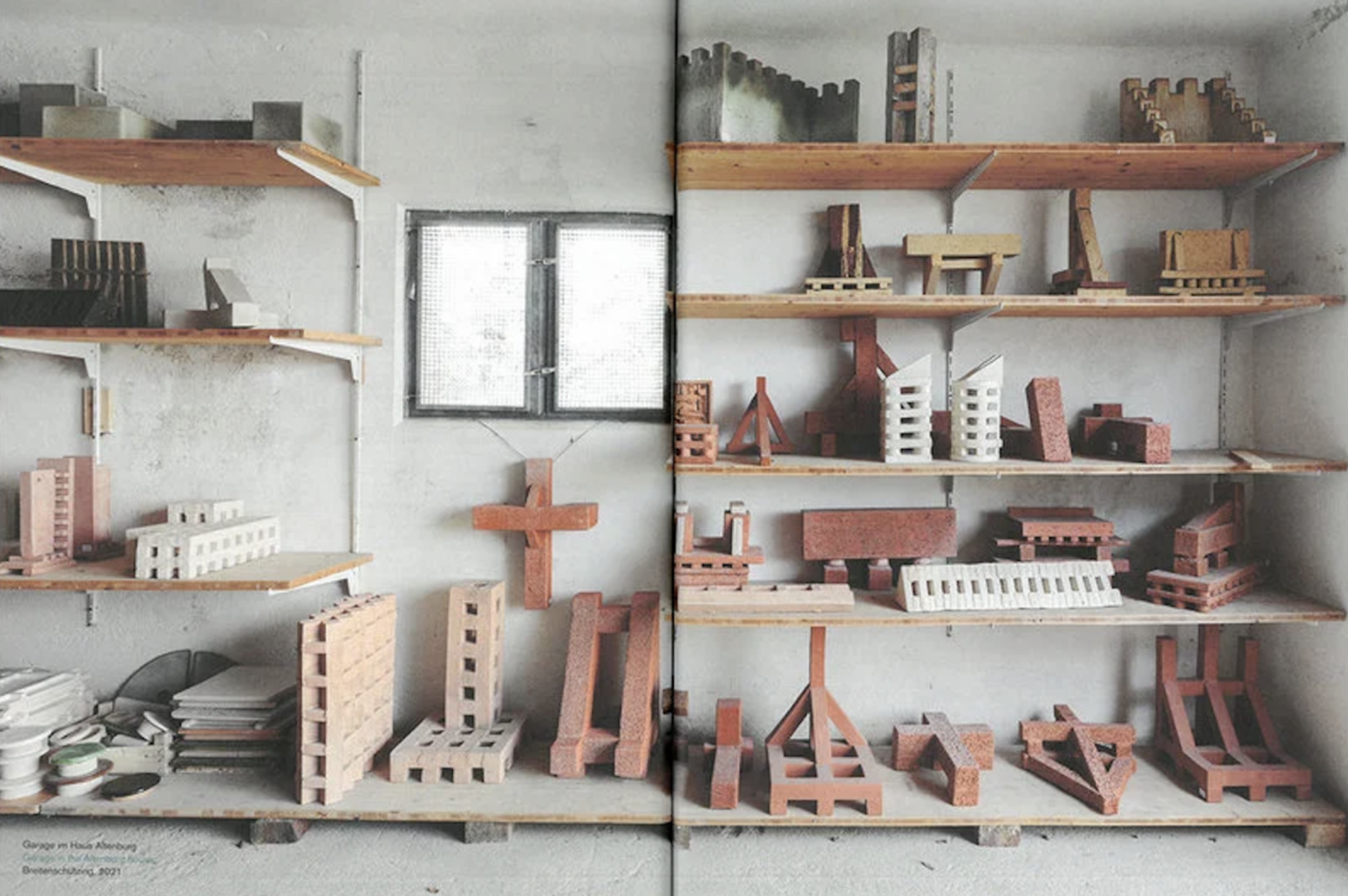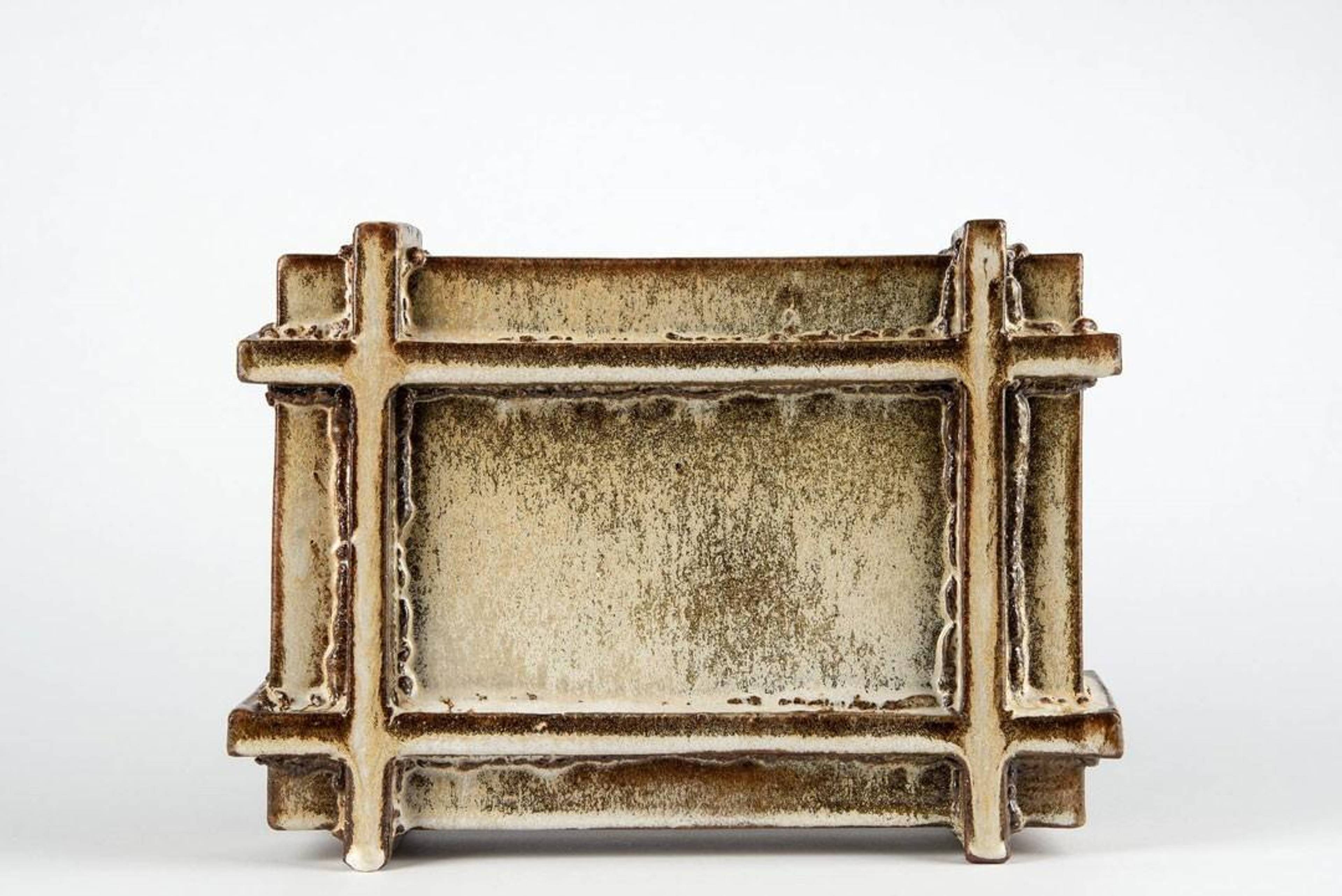Franz Josef Altenburg’s career encompassed the artisanal crossed with the tenets of Modernist sculpture. He was the wizened Janus of an age-old craft from an old European culture that prizes high craftsmanship. An idiosyncratic use of color and unlikely configurations of stacked forms or criss-crossing vertical and horizontal supports define his sculptures. That he managed to reconcile two seemingly incompatible approaches to the same material, clay, makes for a compelling legacy. Let us then look at the work of Altenburg as two sides of the same coin. One situates itself in the category of the utmost elegance of rudimentary functional design, while the other emphatically discards “usefulness” altogether. This was a man who understood the Wittgensteinian notion of “useless forms” and took it to the limits of repetition.
Altenburg’s work takes an indefinable turn when you’re confronted with its sculptural language. And the imprint of the hand is demarcated with fluidity and naturalism. The clay seems a natural extension of an elastic mind, one of elemental order and structure. The table literally turns, all of the logic and gracefulness are intact but the dinner conversation is altered. It pivots from the pragmatism of functional implements to an emphasis on man-made structures. Hence Altenburg can be deemed here a dynamo of form, taking the repetition of one thing and transmuting its properties into etudes of an essence of another.
View of Franz Josef Altenburg, “Block, Haus, Turm, Gerüst, Rahmen,” MAK, Vienna, 2021. © MAK/Georg Mayer
Grouped together and spread across a long pedestal table, the subtle power of these sculptures take on the appearance of a cluster of urban architectural masterpieces. Wave and scaffold shapes, one after the other, spread their totemic loads evenly. A convergence of the horizontal and the vertical supports the whole. A square with a pediment balanced by two columns evokes neo-classical architecture. Other forms seem to be based on Roman aqueducts. Or, as seen in the recently released MAK catalogue, the witty Kiste (Box) from 1983 has shades of a Romanesque castle or tower. And a large floor sculpture conveys industrial strength as a porous block with the patina of glazed concrete. Altenburg also brings to mind Frank Lloyd-Wright’s notion of organic architecture; shades of Fallingwater (1939) are echoed in the gray hued construction of Altenburg’s superb Tower (2018).
Altenburg’s work speaks quietly, yet carries a big stick. It has the stripped-down, unadorned remoteness of an ascetic. Ornamentation is sublimated in the sensorial aspects of his color gradations. A rusty orange tower has the calcinated surface of burnt sienna, and its granular color is as striking and subtle as a Mark Rothko. The same goes for a marvelous red tower. In fact Altenburg’s palette aligns with that of color-field painting, combined with aspects of the industrial metallic finish on Donald Judd’s wall mounted progression sculptures. Color affects perception, rendering the three-dimensional space as something familiar and alienated from itself.
Spread from Franz Josef Altenburg, Clay and Form, 2021. Courtesy: MAK, Vienna
Franz Josef Altenburg, Panel, before 1980, stoneware, formed, glazed. © MAK/Georg Mayer
Solitary as a monk, Altenburg was not part of any art movement per se, but kept tabs on the contemporary movements of his day, and worked for many years for the “Gmundner Keramik”, a private manufactory that supported artists by giving them commissions. In these collaborations, he had the freedom to create special designs in limited editions. Altenburg gravitated to earthy clay with the matter-of-factness and uniformity of modernity in mind, aware of the earlier influence Bauhaus had on his generation. Modernity, and then Minimalism, offered him an escape from the stultifying decorative whimsy of the milieu he was born and bred in. His nascent style would then become a counter-reformation to the exquisite decorative porcelains of old Europe with its remnants of exuberant wealth, power, and privilege.
That sense of absolute quality was however, embedded into the psyche of his temperament. He conveyed the same long-lasting sense of permanence as the fabled 18th and 19th century porcelain, only with a guileless strength of character. He knew what he was after in the clay. Quite literally, in his hands, that value system which prizes sophistication was rerouted from the folly of vainglorious self-indulgent luxury to one of silent meditation. This in itself is an accomplishment. To take the sheen off the object and, like Gustave Courbet, celebrate and honor with rustic simplicity the ultimate refinement, that of the spirit. Here is where his presence is to be felt in objects where he’s turned things inside out, showing you structural ingenuity and the imago of form.
As an artist working in the medium of ceramics, Altenburg fell under the radar of contemporary art. This omission (perhaps a self-imposed one) will be corrected. Cézanne, and Giorgio Morandi come to mind here, two misfits who just didn’t fit in. On a literary note: the American Ralph Waldo Emerson succinctly espoused the idea of Human Culture, not in the symphonic Germanic concept of Kultur, but rather that of bildung, a process of self-education, or self-discovery. A sense of permanence in flux is what permeates Altenburg’s work across the board. As the Janus of clay, his was a journey of sensations in the stabilizing environs of nature. A silent drama communicated the solidity and volume of his objects through a breach in the confinement of space and time. Et in Arcadia ego.
Portrait of Franz Josef Altenburg in his studio, 2019. © Michael Maritsch
___






